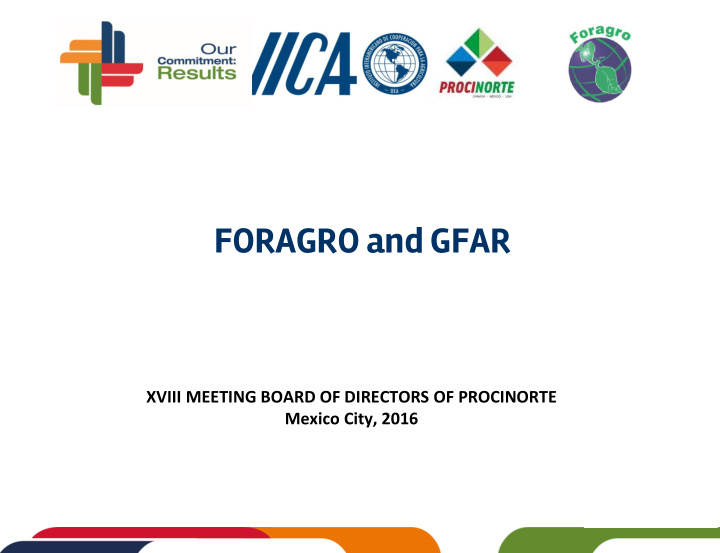



FORAGRO and GFAR XVIII MEETING BOARD OF DIRECTORS OF PROCINORTE Mexico City, 2016
FORAGRO and GFAR: brief history and covergence FORAGRO • Established by a IABA resolution in 1997 and re- endorsed by that body in 2003 • Envisioned as a space for discussion of and agreement on S&T issues facing agriculture in the Americas; a component of an Hemispheric Agrifood Technology and Innovation System. • One of its key roles was to help shape policies • A member of the Global Forum for Agriculture Research (GFAR)
FORAGRO and GFAR: brief history and covergence FORAGRO Over its lifespan the Forum has promoted numerous initiatives under different lines of action, including: • Hemispheric Dialogue • Regional Research and Development Agenda • Prospective Studies • Capacity Building and Exchange of Experiences • Management of Information for Research and Technology Development • Political Presence Since FORAGRO does not have an allocated budget, these activities have been funded through ad-hoc means, mostly through IICA funds and members´ hosting
FORAGRO and GFAR: brief history and convergence GFAR • Established in 1996 by several UN agriculture and food bodies (FAO, IFAD, CGIAR, ISNAR) • GFAR focus is on R&D for development: • VISION: to make agri-food research and innovation systems more effective, responsive and equitable, towards achieving Sustainable Development Goals • MISSION: through its partners, advocate for, and catalyse collective actions to strengthen and transform agri-food research and innovation systems
FORAGRO and GFAR: brief history and convergence GFAR constituency includes regional forums: • AARINENA - Association of Agricultural Research Institutions in the Near East and North Africa • APAARI - Asia Pacific Association of Agricultural Research Institutions • CACAARI - Central Asia and the Caucasus Association of Agricultural Research Institutions, Tashkent, Uzbekistan; • EFARD - European Forum on Agricultural Research and Development • FARA - Forum for Agricultural Research in Africa • FORAGRO (other constituents include the CGIAR, farmers´ organizations, private sector, academic institutions, financing bodies, youth organizations)
FORAGRO and GFAR: brief history and convergence GFAR and the Global Conferences on Agricultural Research for Development (GCARD): Organized by GFAR in partnership with CGIAR “to promote effective, targeted investment, build partnership, capacities and mutual accountabilities to ensure that research will meet the needs of the resource-poor end user .” • GCARD 1 (Montpellier, France, 2010 ). “ Enhancing Development Impact from Research” -> developed roadmap to transform Agricultural Research for Development (AR4D) • GCARD 2 (Punta del Este, Uruguay, 2012). “Foresight and Partnership for Innovation and Impact on Small- holder Livelihoods” -> how to implement roadmap • GCARD 3 (South Africa, 2016). “No One Left Behind: Agri-food Innovation and Research for a Sustainable World” - > 17 “collective actions” focused on diversity, inclusiveness, youth FORAGRO contributed actively with GCARD 1, providing input and positions for the Roadmap. Neither IICA nor FORAGRO sent representatives to GCARD 3
FORAGRO and GFAR: brief history and convergence FORAGRO was conceived from the beginning as an inclusive forum However, there were challenges with securing participation and representativeness of stakeholder groups GFAR began a renewal process in 2012 and held a Constituent Assembly in 2015 , aimed at becoming more inclusive and reflect the needs and views of a variety of stakeholders A new governance was established: • GFAR Partner Assembly • Multi-stakeholder Steering Committee G
FORAGRO and GFAR: recent developments • GFAR has approached FORAGRO with an interest in re- engaging and an offer to support some activities • FORAGRO is undergoing a review and restructuring process of its own with a view to to become more focused, effective, sustainable, and inclusive G
FORAGRO and GFAR: recent developments FORAGRO restructuring (“New FORAGRO”) - Highlights of draft proposal: • Increased and better defined articulation with regional mechanisms (PROCIS, IABA) • A new, more inclusive governance (Assembly of Members, Steering Committee, Technical Advisory Group, Secretariat) • Building a space for multiple national, regional, and global actors • Need to find a mechanism for financial and institutional sustainability • Monitoring and evaluation As part of this process, relationship with GFAR needs to be further articulated
Questions for discussion • GFAR needs FORAGRO as part of its constituency. What are the areas of common ground for interaction. Where do the two forums meet? • GFAR is offering to support FORAGRO on some targeted, punctual initiatives. What topics could be of interest for PROCINORTE? • How can FORAGRO best foster the interaction between regional mechanisms? • In GFAR´s model, FORAGRO plays a role in informing the global forum by contributing to develop hemispheric analyses, priorities and agendas. Would/should FORAGRO be positioned to do this in the future and how would the PROCIs contribute to the process?
Recommend
More recommend